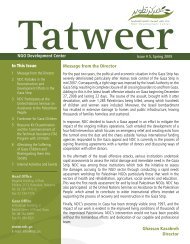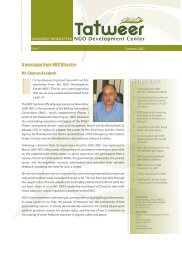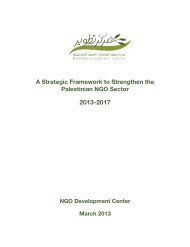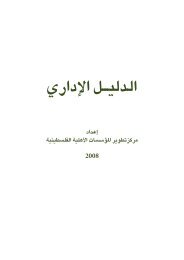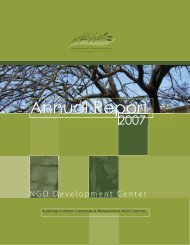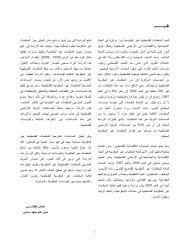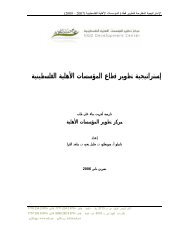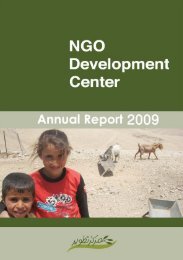Tracking External Donor Funding.pdf - NDC
Tracking External Donor Funding.pdf - NDC
Tracking External Donor Funding.pdf - NDC
You also want an ePaper? Increase the reach of your titles
YUMPU automatically turns print PDFs into web optimized ePapers that Google loves.
Women’s Affairs received 54.9% of their funding from<br />
external donors in 2006. They also record a higher<br />
percentage of self-financing (32.5%) than most other<br />
sectors (MAS, 2007:80).<br />
3.6.4.4 <strong>External</strong> <strong>Funding</strong> to Education-Based PNGOs<br />
Scientific Education<br />
Throughout the period studied, donor funding to<br />
Scientific Education remained relatively small in scale<br />
and consistent – between 2 and 4% of total external aid<br />
to PNGOs. This small number reflects the fact that<br />
external aid flows to this sector primarily through public<br />
bodies, such as the Ministry of Education and Higher<br />
Education (MoEHE), or semi-public bodies, such as Bir<br />
Zeit University.<br />
INGO donors apportioned a slightly higher percentage of<br />
their funds to this sector than Governmental donors, the<br />
most significant year in terms of differences being 2007,<br />
where INGO donors apportioned 6.79% of their funding<br />
to PNGOs in this sector versus 0.27% from<br />
Governmental sources. According to MAS’s 2007<br />
mapping of PNGOs, organizations working in this sector<br />
received 45% of their funding from international aid,<br />
with the remainder split between self-financing, local aid<br />
and aid from the Diaspora (MAS, 2007:80).<br />
Figure 26: <strong>External</strong> <strong>Donor</strong> <strong>Funding</strong> to PNGOs<br />
Working in Education-Based Development (1999-2008)<br />
10%<br />
9%<br />
8%<br />
7%<br />
6%<br />
5%<br />
4%<br />
3%<br />
2%<br />
1%<br />
0%<br />
1999 2000 2001 2002 2003 2004 2005 2006 2007 2008<br />
Liberal Arts Education<br />
Scientific Education<br />
Religious Activities<br />
Research<br />
Source: MAS, 2009 – <strong>Donor</strong> Survey<br />
Research<br />
<strong>External</strong> funding for PNGOs engaged in Research<br />
remained steady between 2 and 3%. Governmental<br />
donors apportioned a higher percentage in the early<br />
years, but the pattern was reversed in 2006 and 2007<br />
with INGO donors contributing more. In 2008,<br />
Governmental donors contributed significantly more than<br />
their INGO counterparts (5.13% and 1.64%<br />
respectively). In 2006, PNGO research institutes<br />
received 71.8% of their funding from external donors<br />
(MAS, 2007:80).<br />
Liberal Arts Education<br />
Aid to PNGOs working in the Liberal Arts sector began<br />
to rise in 2001 with the onset of the Intifada and the<br />
corresponding increase in funding toward peace building.<br />
There is a slight decline between 2002 and 2003, after<br />
which funding stabilized around 8% of total external aid<br />
to PNGOs before beginning to recover again between<br />
2006 and 2008 to nearly 8%.<br />
INGO and Governmental donors followed similar trends,<br />
with the latter apportioning a higher percentage of aid.<br />
According to MAS’s PNGO mapping (2007), this sector<br />
received 60.1% of its funding from international aid. The<br />
Liberal Arts sector also received by far the highest<br />
percentage of of their funding from ‘Palestinians within<br />
the Green Line’ or ‘1948’ers.’(24.3%).<br />
Religious Activities<br />
<strong>External</strong> funding to PNGOs engaged in religious<br />
activities is not captured well in this survey. We do know<br />
from previous studies that religious PNGOs receive<br />
nearly 90% of their funding from abroad, one would<br />
have to assume from regional sources – which are also<br />
the least represented in our study.<br />
42


